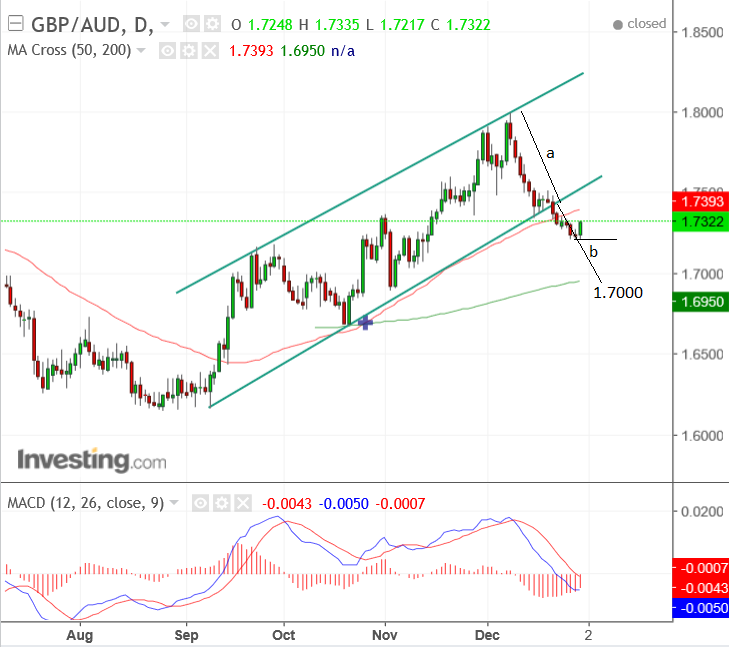The Pound-to-Australian Dollar Rate Over the Next Five Days, Including Technical Forecast, Data, and News

The Pound-to-Australian Dollar rate looks markedly bearish in the short-term whilst the main data releases in the week ahead are Australian trade data and new UK sector-specific activity data for December.
The charts are showing the Pound-to-Australian Dollar has broken down out of its rising channel and started moving lower.
The usual way to forecast how far the exchange rate will fall after a channel breakout is to take the height of the channel (labeled 'a') and extrapolate it lower (labeled 'b') to get the expected target, which yields a target just below 1.7000.

Get up to 5% more foreign exchange by using a specialist provider by getting closer to the real market rate and avoid the gaping spreads charged by your bank for international payments. Learn more here.
The 200-day moving average (MA) also happens to be at the 1.7000 level which reinforces it as a possible end-point because moving averages can provide dynamic support where down- trending markets will stall, or even bounce.
Traders often attempt to profit from the expected bounce by buying the currency at the level of the moving average and this tends to magnify the effect.
A break below the 1.7213 lows would provide confirmation of more downside to the 1.7000 target.
The MACD has dipped below the zero-line which is the signal the trend has changed and adds weight to the bearish forecast.
Data and Events for the Australian Dollar
The main data release for the Aussie Dollar is the trade balance on Friday, January 5, at 00.30 GMT.
The trade balance is the difference between the value of goods country imports compared to the value of the goods it exports.
If the trade balance shows a surplus it tends to be positive for the currency because it reflects a rise in net demand for the currency and vice versa for a trade deficit in which imports outweigh exports.
Markets currently expect Australia's trade balance to show a rise in the surplus to 1.375bn in November from 0.105bn in October, however, not all analysts agree, and Canadian investment bank (IB) TD Securities are sceptical.
"Chinese trade data for Nov set up for a dire Australian report, with flat exports and a substantial surge in imports. We expect a slip into deficit for November, defying consensus expectations for a slightly wider surplus compared with October," says the Toronto-based IB.
Data and Events for the Pound
The main release in the coming week for the Pound will be key purchasing manager survey data assessing the health of the three main sectors of Manufacturing, Services, and Construction in December.
These releases are officially known as the PMI (Purchasing Manager Indices) and they are out at 9.30 GMT on Tuesday, December 2 for Manufacturing and Wednesday and Thursday at the same time for Construction and Services respectively.
Manufacturing is expected to have fallen from 58.2 to 58.0, Construction from 53.1 to 52.7 and Services to have remained unchanged at 53.8.




